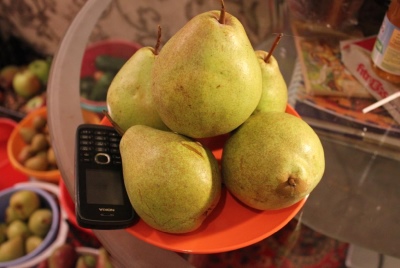
- Authors: Moldavian Research Institute of Horticulture, K. K. Dushutina
- Appeared when crossing: Triumph of Vienne x Olivier de Serre
- Fruit weight, g: 200-300
- Ripening terms: autumn
- Fruit picking time: early or mid September
- Appointment: dining room
- Growth type: undersized
- Yield: high
- Marketability: high
- Height, m: 2-2,2
Summer residents and farmers who grow fruit trees try to select varieties with high yields and the simplest possible agricultural technology. These types include the pear tree Treasure, popular in the southern regions.
Breeding history
Pear Treasure is an achievement of Moldovan breeders. The author of the species is K. K. Dushutina, a representative of the Moldavian Research Institute of Horticulture. The variety was bred by crossing two types of French selection - Olivier de Serre and Triumph of Vienne.
Description of the variety
The treasure is a low-growing tree, the height of which does not exceed 2-2.2 meters. The fruit tree is characterized by a broad-pyramidal crown with hanging branches, moderate thickening with large light green leaves, an extensive root system and a flaky grayish bark. The branches that form the skeleton of the tree grow at right angles. During the flowering period (first half of May), the trees are covered with beautiful flowers that emit a pleasant aroma.
Fruit characteristics
Treasure is a large-fruited pear species. The average fruit weight is 200-300 grams. The shape of the fruit is wide-conical. The pear grows on a curved and shortened stalk. Ripe fruits are endowed with an unusual color - light yellow with a greenish tint and rusty specks. The surface of the fruit is characterized by a slight tuberosity. The peel of the pear is dense, even thick. If you look closely, you can find subcutaneous points on the surface of the pears.
A feature of the fruits is their good transportability and long shelf life - up to 3-4 months with the preservation of taste and marketability. The purpose of the variety is table, so pears are eaten fresh, used in cooking and processed.
Taste qualities
The taste of the pear is excellent, even the name of the variety testifies to this. The flesh, white with yellowness, is endowed with tenderness, fleshiness, oiliness and juiciness. The taste is dominated by rich sweetness, complemented by sugar content, which is diluted with pleasant sourness. There is no graininess in the pulp. The concentration of nutrients is found under the skin of the fruit.
Ripening and fruiting
Pear Treasure belongs to the class of autumn varieties. The tree bears fruit in the 5-6th year after planting. Fruiting of the variety is regular. The peak of fruit ripening on the tree is in the first half of September. You can shoot ripe pears until early October.

Yield
Yield indicators directly depend on compliance with the rules of agricultural technology and weather conditions. On average, one tree produces about 40 kg of ripe fruit per season.
Growing regions
The Sokrovische variety has proven itself to be excellent, growing on the territory of Moldova and Ukraine. In Russia, pears are massively grown in the southern regions. In addition, in recent years, the Treasure began to be grown in Belarus.
Self-fertility and the need for pollinators
The pear needs pollinators. To do this, it is recommended to plant donor trees on the site, the flowering period of which completely coincides with the Sokrovische variety. The following pear varieties are considered the best pollinating trees: Conference, Lyubimitsa Klappa, Plovdivskaya, Bere Mlievskaya, Williams, Melting and Decanka du Comis.
Landing
It is better to plan the planting of a seedling in early spring, when the threat of night frosts is over. When planting a tree, it is necessary to maintain a distance between seedlings - at least 3 meters between trees and buildings. For planting, it is recommended to choose seedlings 1-2 years old with a formed and strengthened root system.


Growing and care
The pear is not capricious in its care, but it is very demanding on the soil and place of growth. Loamy soil or black soil with a low acidity level is suitable for a tree. The soil should be loose, lightweight, breathable, moisture-permeable and fertile. The site should be abundantly illuminated by the sun.
Comprehensive care consists of: regular watering (2-4 times a month), top dressing starting from the second year of growth, loosening the soil of the near-stem circle, sanitary pruning of branches twice a year, protection from pests and fungi. In addition, do not forget about the insulation measures for the winter period - barrel winding and mulching.



Disease and pest resistance
The pear has a strong immunity to major diseases and pests. The tree is practically not affected by scab, it resists fruit rot, brown spot, bacterial cancer and powdery mildew well. In addition, the tree is not afraid of moth invasions.

Like any other fruit trees, the pear needs protection from various diseases and pests. When planting a pear on your site, you need to know in advance what diseases you should beware of. To successfully carry out the struggle, it is necessary first to correctly identify the cause of the problem. It is important to distinguish signs of disease from manifestations of the presence of insects, mites, caterpillars and other types of pests.
Resistance to soil and climatic conditions
The variety has medium stress resistance. It is able to withstand temperature extremes, short droughts and prolonged heat, since the pear is thermophilic. The tree does not like strong drops in temperature, withstanding frosts up to 20-22 degrees, and shading. In addition, the structural features of the root system make the tree a lover of space.





































































